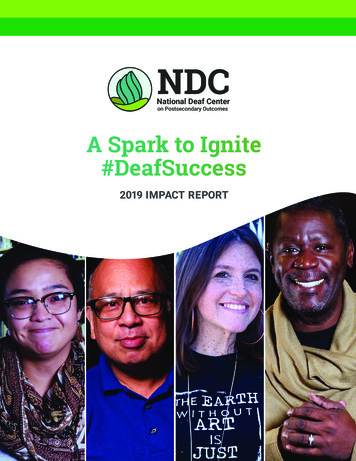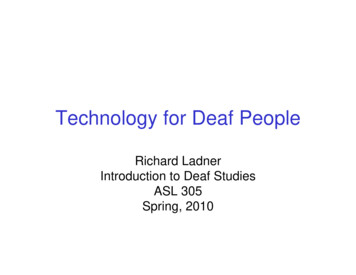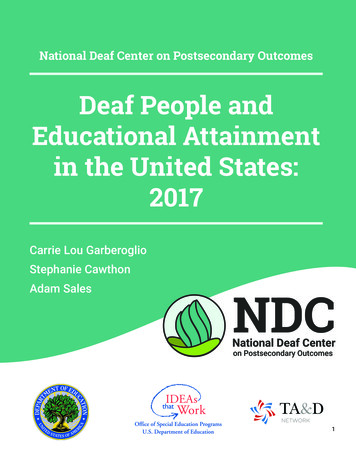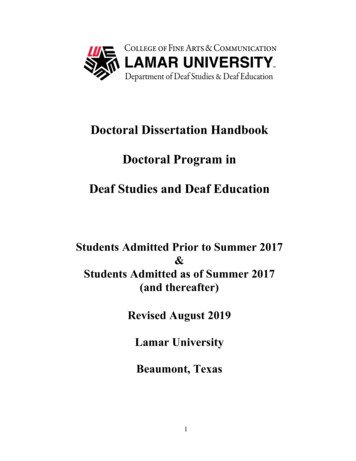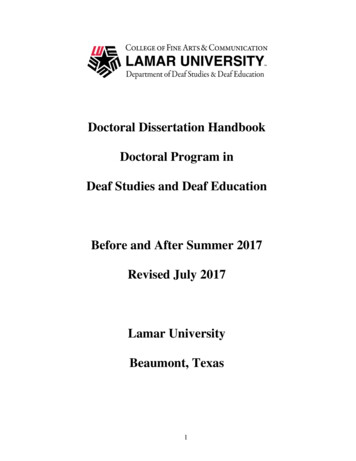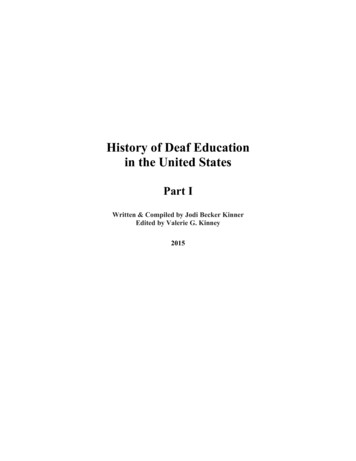
Transcription
History of Deaf Educationin the United StatesPart IWritten & Compiled by Jodi Becker KinnerEdited by Valerie G. Kinney2015
Deaf Genes in Martha’s VineyardBefore we explain Utah Deaf history, it is important to talk about national Deafhistory that has roots traced to Deafness commonplace on Martha’s Vineyard, off thecoast of Massachusetts for 250 years, beginning with a Deaf resident named JonathanLambert in 1694. The gene for Deafness was spread through generations of hisdescendants through intermarriage among the isolated islanders (Shapiro, 1994). Eightyfive percent of Deaf children had two hearing parents but most had other Deaf relatives(Roberts, 1994). On this island, there were no language barriers; the entire communityused sign language, even when there were no Deaf members of the community present.Deaf islanders were full and equal participants in a bilingual society. They marriedhearing people and were respected and active members of their community, holdingimportant posts. To the islanders, Deafness was normal, not a sickness, and it was notviewed as disabling because everyone was bilingual (Groce, 1985; Shapiro, 1994; Foster,1998).First Deaf School in AmericaIn 1817, the American Asylum for the Deaf and Dumb (later named AmericanSchool for the Deaf) was established in Hartford, Connecticut, by two men who becameAmerica’s earliest and most influential educators of the Deaf: Thomas HopkinsGallaudet, a hearing minister, and Laurent Clerc,an intellectual Deaf leader in France and fatherof American Deaf education. American SignLanguage was created from Clerc’s French signlanguage which was modified and also bysigned communication brought to the school byDeaf students. This eventually becameAmerican Sign Language (ASL). Deaf studentsat this school were taught in ASL and becameThomas Hopkins GallaudetPhoto courtesy of the GallaudetUniversity Archivesequally as literate as their hearing peers. With1
teachers being fluent signers and teaching with ASL, literacy skills of their Deaf studentswere impressive (Shapiro, 1994).The next generation of Deaf students then went on to become teachers andprincipals at schools for the Deaf. Over the years, thisschool served as the “Mother School” in providing amodel educational program. Hundreds of these Deafstudents went forth to become teachers to educate andto establish numerous schools for the Deaf all over thecountry, which spread sign language, and went on tofound Gallaudet University in Washington, D.C. in1864 (Gannon, 1981; Shapiro, 1994). The concept ofDeaf education was similar to bilingual education: ASLand written English were the language of instruction.Laurent ClercPhoto courtesy of theGallaudet UniversityArchivesThe Origins of Oral MovementThe origins of oral movement in the United States began in 1843, when twohearing American educators, Dr. Samuel Gridley Howe and Horace Mann, who had nofamiliarity with Deaf people, went to Europe to study education systems. In Germany,they were surprised to find Deaf children who couldspeak and read lips. Upon their return to America,Howe and Mann published a report strongly urgingthe instruction of speech and lip-reading. Someadministrators in American schools for the Deafdecided that spoken methods could be used forcertain individuals with partial hearing, especiallythose who had lost their hearing after acquiringDr. Samuel Gridley HoweSource: Wikipedia2
speech, but sign language would remain the dominant mode of instruction (Pace, 1946).Interest in oral education began to surge. The next major development came whenthe first oral school, Clarke School for the Deaf, was founded in 1867 by a millionaireBostonian named Gardiner Greene Hubbard, father-in-law to Alexander Graham Bell inNorthampton, Massachusetts. It became the first permanent oral school for the Deaf inthe United States. The second oral school, HoraceMann School for the Deaf, was founded as a dayschool in Boston, Massachusetts in 1869, and was thefirst school of this type ever established. Its firstprincipal, Sarah Fuller, who retained the position forforty-one years, was Helen Keller’s speech instructor.Shortly thereafter, these oral schools set the pattern ofincreasing number of the oral schools, especially theday schools, in the 1860s (Pace, 1946; Shapiro, 1994).Horace MannSource: WikipediaThe Most Influential Oral AdvocateIn the 1870s, the most influential oral advocate in America, Alexander GrahamBell, re-emphasized speech training for Deaf Americans. His father, Alexander MelvilleBell, was a master of phonetics and his mother, ElizaGrace, was hard of hearing. While she had enoughhearing to use an ear tube for one-on-oneconversations, Mr. Bell often used the manual alphabetto communicate with her. Ironically, he knew signlanguage well, but he insisted on speech as being thebetter method. His wife, Mabel Gardiner Hubbard, wasDeaf, but she did not use sign language (Pace, 1946;Winefield, 1987).Alexander Graham BellSource: Wikipedia3
Most Americans know Dr. Bell as the inventor of the telephone. In 1876, at theage of 29, he patented a device to send the spoken word over a wire originally called the“electrical speech machine.” He thought it would benefit his wife and hoped the focusedsound would be heard by the Deaf. Instead ofbenefiting his wife as Mr. Bell had hoped it would, the“electrical speech machine” now known as a telephoneactually became a barrier to the Deaf! Due to Dr.Bell’s invention of telephone, he became famous andwealthy. His invested some of his wealth, in additionto his prestige and fame, into the oral movement(Gannon, 1981; Lane, Hoffmeister, & Bahan, 1996).Throughout Dr. Bell’s life, he was interested inthe education of Deaf people and was one of the mostprominent proponents of oralism. He campaignedMabel Gardiner HubbardPhoto courtesy of theAlexander and Mabel BellLegacy Foundationvigorously for oralism and full assimilation of Deafpeople into hearing society, and was against sign language, intermarriage among Deafpeople, and residential schools (Erting et al., 1989; Van Cleve & Crouch, 1989; Shapiro,1994; Parasnis, 1998).Establishment of the National Association of the DeafSince the founding of the first Deaf school in Hartford in 1817, state associationsof the Deaf were established in several states (Gannon, 1981). The National Associationof the Deaf was established when Deaf representatives from numerous states gathered forits First National Convention in Cincinnati, Ohio in August of 1880 (Gannon, 1981; VanCleve & Crouch, 1989). The Cincinnati attendees were products of nearly 60 years of anAmerican Deaf school system. These Deaf attendees held various positions, such asteachers, school founders, principals, businessmen and leaders. They were determined toimprove Deaf people’s quality of life by opposing laws that would restrict their rights,determining to discourage imposters and Deaf peddlers, creating a better understanding4
of Deafness by the public at large, pushing for better vocational training in the schools,providing better educational methods, and lastly, fighting employment discrimination(Gannon, 1981).The Infamous Milan Congress of 1880A few weeks after the establishment of the National Association of the Deaf, theSecond International Congress on Education of the Deaf met in Milan, Italy onSeptember 11, 1880. In sharp contrast to the desires of Deaf people from throughout theworld, they adopted the oral method as the “best” method in Deaf education (Van Cleve,& Crouch, 1989; Parasnis, 1998; Shapiro, 1994).Oral advocates, who had organized the convention,agreed to promote speech methods and prohibitsign language. They voted overwhelmingly tosupport oral education. Out of more than 150participants were present, James Denison, aKendall School principal in Washington, D.C., wasthe only Deaf delegate to the Milan Congress.Only five, including Thomas Hopkins Gallaudet’sEdward Miner GallaudetPhoto courtesy of the GallaudetUniversity Archivestwo sons, Thomas Gallaudet, Episcopal priest of StAnn’s Church for the Deaf and Edward MinerGallaudet, president of Gallaudet College, were from theUnited States. Americans believed that sign language should be used as a method ofinstruction in the education of Deaf children. However, the majority oral advocates fromEurope and United States voted to support the oral method to be used in Deaf education.Oral advocates in the United States were ‘excited about benefits of a victory engineeredby European oralists,’ which resulted of the growth of the oral movement in America(Buchanan, 1850-1950, p. 25; Van Cleve & Crouch, 1989).5
Establishment of Alexander Graham Bell Association for the DeafIn 1890, the Alexander Graham Bell Association for the Deaf was founded andfunded to promote the teaching of speech to the Deaf. Today, the organization is theworld's largest organization focused on teaching spoken language to the Deaf. Dr. Bell'sadvocacy for oral education profoundly impacted the way the Deaf children were taught.The Pendulum of Deaf EducationDespite Edward Miner Gallaudet’s best effort to prevent the growth of pureoralism, the Milan decision and Dr. Bell’s efforts, the pendulum of Deaf education inAmerica towards the use of speech as the primary means of communication in theclassroom for Deaf students, established the localoral day schools, eliminated sign instruction fromresidential schools, and replaced Deaf teacherswith hearing instructors (Winefield, 1987;Parasnis, 1998). Dr. Bell’s chief adversary, Dr.Edward Miner Gallaudet, espoused bilingualeducation of Deaf students, including those whowere capable of spoken English. Dr. Gallaudet wasraised by a Deaf mother, Sophia Fowler Gallaudet.Unlike Dr. Bell’s mother, Sophia had no usablehearing, and she had unintelligible speech. Shecommunicated in sign language. He saw hersuccess, strongly influencing his opinions oncommunication methodologies. She not onlySophia Fowler GallaudetPhoto courtesy of the GallaudetUniversity Archivesinfluenced his choice of communication method, but also influenced his entire attitudetoward Deafness (Winefield, 1987). However, following the Milan Conference, an oraleducation was promoted and bilingual education quickly declined.6
Dismissal of Deaf TeachersAfter the Milan Conference ended, hundreds of Deaf teachers in Europe weredismissed from their jobs in favor of hearing teachers who did not know sign language.Sign language was banned in the majority of schools for Deaf children (Buchanan, 18501950; Erting et al., 1989; Shapiro, 1994).In the United States, most Deaf leaders and teachers urged favor of the combinedsystem of instruction as the primary means of educating Deaf children. They battledferociously to defend the residential schools and to preserve sign language. However,hearing educators in favor of the oral method prevailed. With the strong oral movement,Deaf principals lost their jobs to hearing people. Deaf teachers were not totally eliminatedfrom the school were usually assigned to teach older children who were labeled, “oralfailures.” These teachers could no longer pursue academic subjects (Buchanan, 18501950; Erting, et al., 1989). Erting et al. (1989). It was stated that oralism had taken itstoll. Deaf children’s academic achievement was far from satisfactory and Deaf people atlarge thought of their language and themselves as inferior and inadequate, as they had sooften been told by those educators who were in control of their education.Survival of the Deaf CommunityDespite suppression of sign language in the educational system, Deafcommunities around the world continued to survive. Since 1880, Deaf people maintainedtheir languages and communities in spite of efforts to prevent them from associating withone another. At residential schools, sign language was passed on from Deaf parents totheir own Deaf children and to the other Deaf children through interaction with theirpeers as well as the few Deaf adult employees. While sign language was banned from theclassroom, it was used freely in the dormitories and on the playgrounds of residentialschools. Furthermore, people continued to socialize at their clubs, compete in Deaf sportevents, publish newspapers and magazines, and participate in the state associations toimprove their lives (Buchanan, 1850-1950; Erting et al., 1989; Parasnis, 1998).7
BibliographyBuchanan, Robert M. “Illusion of Equality: Deaf Americans in school and factory: 1850 1950.”http://books.google.com/books?id Tahfhls7TKYC&pg PA28&sig VbCZINlmYggHd34t9GD udkD dY&dq this of utah school for the Deaf %221894%22 %22In 1894, Portland%27s newspapers carried a series of exchanges that pitted American School officials and Deaf activists against Bell and Yale.%22Erting, Carol J, Johnson, Robert C., Smith, Dorothy L, & Snider, Bruce D. The DeafWay: Perspectives from the International Conference on Deaf Culture: Papers.Washington, D.C.: Gallaudet University Press, 1989.http://books.google.com/books?id bqJxAcmA9yEC&printsec frontcover&dq Deaf bilingual education in Sweden and Denmark in 1981&source gbs summary r&cad 0#PPR26,M1Gannon, Jack R. Deaf Heritage: A Narrative History of Deaf America. Siler Spring,Maryland: National Association of the Deaf, 1981.Groce, Nora Ellen. Everyone Here Spoke Sign Language. Massachusetts: HarvardUniversity Press, 1985.Lane, Harlan, Hoffmeister, Robert, & Bahan, Ben. A Journey into the DEAF-WORLD.San Diego, CA: Dawn Sign Press, 1996.Pace, Irma Acord. “A History of the Utah School for the Deaf.” The Utah Eagle, vol. 58,no. 1 (October 1946): 1-33.Parasnis, Ila. “On interpreting the Deaf Experience Within the Context of Cultural andLanguage Diversity.” Cultural and Language Diversity and the Deaf Experience.Cambridge, NY: Cambridge University Press, 1998.Roberts, Elaine M. “The Early History of the Utah School for the Deaf and Its influencein the Development of a Cohesive Deaf Society in Utah, circa. 1884 – 1905.” Athesis presented to the Department of History: Brigham Young University.August 1994.8
Shapiro, Joseph P. No Pity: People with Disabilities Forging a New Civil RightsMovement. New York: Random House Publishers, 1994.Van Cleve, John Vickery & Crouch, Barry A. A Place of Their Own: Creating the DeafCommunity in America. Washington, D.C.: Gallaudet University Press, 1989.Winefield, Richard. Never the Twain Shall Meet: Bell, Gallaudet, and theCommunications Debate. Washington, D.C.: Gallaudet University Press, 1987.9
of American Deaf education. American Sign Language was created from Clerc's French sign language which was modified and also by signed communication brought to the school by Deaf students. This eventually became American Sign Language (ASL). Deaf students at this school were taught in ASL and became equally as literate as their hearing peers .




